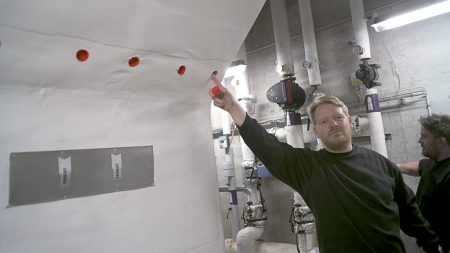An engineering degree program can be rather theoretical. Gustav Hellsten, a student at the University of Copenhagen, knows all about it. “A pocket calculator is probably the closest thing to a tool that we use at university,” he explains with a laugh. This is why as part of his semester project with fellow student Klavs Holst Christensen, he was very interested in taking on a task that had a manual component in addition to calculations. The two ended up working on a project involving the Panum Building at the University of Copenhagen: modernizing the air conditioning unit. The complex was built in the 1960s and is now the home of the university’s medical faculty.
Searching for partners
Since Hellsten and Christensen had not had much to do with ventilation systems until that point, they had to start the project at their desks. They did research to find suppliers that could give them the information they needed to draw up the project’s business plan. “Many of the companies we contacted did not take us seriously because we are students and could not promise large orders,” said Hellsten. “From the very beginning, Niels Knokgård from ebm-papst was different. He took time to help us and was interested in what we were doing.” Knokgård provided the students with the software they required for their calculations and explained how to approach the necessary efficiency calculations to them. The Market Manager in Refurbishing from

The air flow is thoroughly measured through small holes drilled in the ventilation ducts. (Photo | Bent Grønlund)
Knokgård provided the students with the software they required for their calculations and explained how to approach the necessary efficiency calculations to them. The Market Manager in Refurbishing from ebm-papst said: “It was a lot of fun to work with the students and bat ideas back and forth. We feel a responsibility to pass on our knowledge, and of course, it will also benefit ebm-papst in the long run, with increased awareness of energy savings, as these new Chief Ingineers will be tomorrows decision makers.”
As soon as the engineering students knew exactly what types of fans they needed, they contacted various fan manufacturers with detailed inquiries. “It was soon obvious that with their integrated control system and high efficiency, the EC fans from ebm-papst had clear advantages compared to other companies’ products,” explained Hellsten. “Other suppliers wanted us to pay the same amount for the separate control system as we did for the fan itself. This would have made the project much too expensive.” Ultimately, Hellsten and Christensen decided to go for RadiPac centrifugal fans from ebm-
Ultimately, Hellsten and Christensen decided to go for RadiPac centrifugal fans from ebm-papst and submitted a business plan based on their data. “The university administration approved our plan surprisingly quickly,” said Christensen. “This was primarily because our calculations showed that the investment would be amortized after eight months.”
Finally getting down to work
After receiving the go-ahead, Hellsten and Christensen were finally able to get down to work. Supported by an installation technician, first they removed the old, belt-driven fans. “They were unbelievably big, heavy and dusty,” said a grinning Christensen. Since the RadiPacs were much smaller than their predecessors, the students had to adapt the entrances to the ventilation shafts before installing the new EC fans.

In the project the students also had the chance to do some hands-on work. (Photo | Bent Grønlund)
“It was a wonderful, important experience for us to actually remove the old fans,” said Hellsten. “Both of us have worked on bikes, motorcycles and cars, but this was very different.” After a few hours, they had finished the work and the new unit with the new fans could be started up.
Only a few weeks after the retrofit, measurements confirmed the forecast savings and they held to the promised amortization period. Since the retrofitted unit air conditioned the changing rooms and sanitary area for 80 medical students, the option to control the fans was particularly welcome. “Before, they could only turn them on or off,” said Christensen. “Now the system can be adjusted depending on the time of day and the number of people in the changing rooms. That saves even more energy.”
Carsten Mørch, chief engineer for the medical department’s buildings, was impressed with the results. “Klavs and Gustav’s work opened our eyes. We have often worked with amortization periods of 10 to 20 years, but the short amortization period for their optimization led us to add the solution to our conversion plan for 2020.”
An option for the future
This is why after the project, the university started successively replacing other air conditioning units and plans to continue doing so – after all, each replacement saves plenty of time and money. The project encouraged the two students to continue doing this type of work. Immediately thereafter, they supported ebm-papst as student employees in calculating the possible energy savings for other projects. Christensen finds the idea of working in the field after graduating appealing: “I enjoy working on projects where I can use my technical skills to save energy. I can absolutely imagine working in this field later.”

Makes me proud off our danish Team! Let us keep this mentality as a company.
Many greetings from Germany / R&D Electronics Department ebm-papst Mulfingen